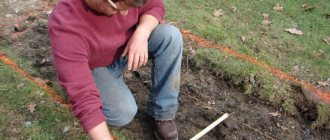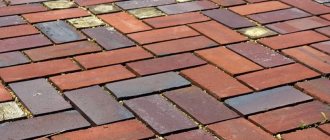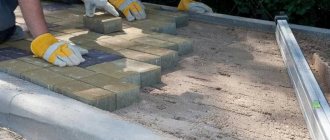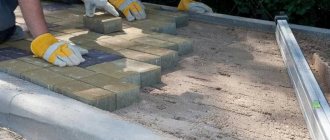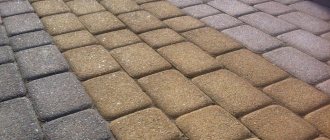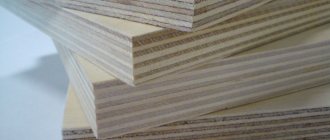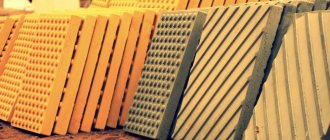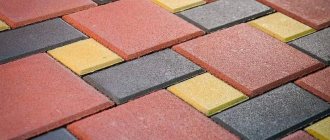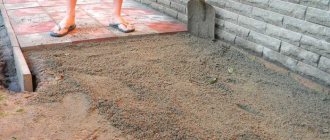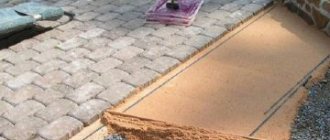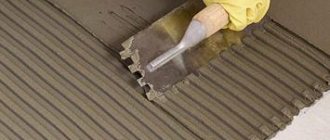Paving slabs are valued for their practicality, high strength, durability, resistance to moisture and temperature changes. It does not emit substances harmful to humans when heated, like asphalt pavement. The variety of shapes, sizes, colors and textures of road building materials is amazing. By combining different types of products, you can create beautiful coatings. Laying paving slabs requires strict compliance with all construction regulations. If paving technology is violated, the coating quickly collapses.
Marking future paths
To correctly lay out the tiles yourself, you first need to make markings. You need to start work near a building, fence or gate. Near the structure you need to hammer in 2 pegs. The distance between them should correspond to the width of the track. It is better to adjust the width of the coating to the size of the product so that you do not have to cut the material. Since the structure will be supported by curbs, it is necessary to leave space for them (10 cm on each side). The other 2 pegs are driven near another building. 2 ropes are pulled between the pegs.
Laying street tiles over a large area is carried out after dividing it into strips 1-1.5 m wide. If the road has bends, it is divided into small sections. Each section is marked separately.
Excavation and protective layer
The volume of excavation work depends on the type of soil. If the soil is dense and clayey, it is enough to remove a layer 15-20 cm thick to remove plant roots. When the soil is loose, it is necessary to remove a layer 30-35 cm thick. If you plan to lay paving slabs in winter, the paving trench must be prepared before the cold weather.
Sand is poured onto the surface of the trench. The sand is compacted together with the soil. To prevent plant seeds remaining in the soil from germinating and destroying the coating, a non-woven fabric is laid at the bottom of the trench. The strips of material should overlap each other by 15-20 cm.
Basic elements of landscape design
Landscaping using natural components is carried out by land owners in accordance with their preferences, needs and financial capabilities. However, in order for the opening landscape to please the eye, it is necessary to take into account many nuances.
Laying paving stones
It is important to pay attention to the location and appearance of the main groups of elements:
- buildings, both residential and auxiliary;
- lawn;
- green spaces;
- artificial reservoirs;
- small architectural forms, decorative details;
- technical components, such as lighting, watering system, etc.;
- platforms and paths.
Paving slabs in the landscape
Garden paths can perform a primary function - providing access to objects, or a secondary function, allowing you to walk around the territory. Properly made, they help you move comfortably, without fear of getting your feet dirty. The main materials used in their construction are paving slabs and paving stones.
When choosing the type of coating, the area of the site, the characteristics of the material, and the type of cladding of buildings are taken into account. Many, using their design abilities, combine different types of products.
Types of garden paths
Drainage device
Proper installation of tiles does not guarantee the durability of the coating. Groundwater and rainwater gradually wash away particles of sand and soil, destroying the base of the road. To prevent moisture from spoiling the coating, it is necessary to make a drainage layer.
You need to pour crushed stone at the bottom of the trench. The layer thickness should be 15-18 cm. The crushed stone must be well compacted and leveled. A thin layer of sand is poured on top and also leveled, on which a non-woven fabric is laid. Care must be taken to ensure that water flows to the edges of the path. For this purpose, transverse and longitudinal slopes are made. The cushion under the paving slabs is carried out at the last stage of preparatory work.
Required Tools
Before laying paving slabs, you should prepare in advance additional materials and tools that will be useful primarily when performing the work, for example:
- cement;
- curbs, which can be either plastic or stone;
- crushed stone, the fraction of which should not be more than 40 mm;
- geotextiles;
- shovel;
- a manual concrete mixer, however, if you don’t have one, you can do without it;
- hammers;
- sand.
As for the amount of materials required to design the paths, before carrying out the work it is necessary to carry out preliminary calculations, taking into account the characteristics of the soil, the area of the territory, and the features of operation.
Placement of boundary borders
Laying the curb is carried out immediately after completing the drainage work. It is better to use a ready-made concrete curb. Curb blocks are installed near the vertical cut of the soil along the edges of the road. It is desirable that the top edge of the border is 1-2 cm above the soil level. Otherwise, the paths will be constantly dirty.
Curb blocks are secured with concrete mortar. After laying the curb, you need to check how even it is. To do this, use a building level. If some blocks are installed incorrectly, their position is corrected with a wooden mallet.
Types of bases used
Before you lay out the tiles, you need to make a base. The underlying layer helps to level the surface of the area. It gives the coating stability and increases its strength. A reliable foundation prevents the sidewalk from collapsing under the weight of people and cars. It protects the coating from destruction in the autumn-winter period, when ice forms in its gaps.
The technology for laying paving slabs depends on the method of use of the coating. If the load on its surface is small (pedestrian path), it is enough to make an underlying layer consisting of sand and cement. If paving is carried out under a car, a concrete base is required.
Concrete
Before concreting the base, reinforcement work is carried out. The reinforcing mesh is laid on metal or stone supports. The reinforcement should be 3-5 cm above the surface of the trench. The lining for paving slabs is prepared from sand and cement in a ratio of 3:1. It is better to use washed river or quarry sand. It should not contain particles of clay or lime. The solution is evenly and carefully distributed over the trench area to achieve a smooth surface.
It is better to fill the entire path with concrete at once. If part of the work is postponed until the next day, the area filled with concrete must be covered with polyethylene. The concrete base for paving slabs should have a thickness of 10-12 cm. In order for the cement pad to be strong, it must be moistened for 3-5 days. After moistening, the concrete is covered with polyethylene. The coating can be laid after 7-12 days.
From sand and cement
The trench is filled with a mixture of sand and cement. It is prepared in a 3:1 ratio. The thickness of the sand-cement base should be 12-15 cm. The underlying layer must be well compacted and leveled. If the depth of the trench is too deep, it can be reduced with sand. Sand is poured under the base and compacted thoroughly.
The technology of paving with paving slabs requires that the cement-sand mixture be dry. Therefore, it is better to make the base immediately before paving in dry weather. The cement-sand layer must be laid on geotextiles. If this is not done, the sand will quickly wash out and the tiles will sag.
What are the benefits of concrete paving stones?
It is no coincidence that the products are actively used for paving paths and constructing parking lots. This is due to their excellent performance characteristics:
- high strength and wear resistance, allowing to withstand the constant movement of a large number of people and vehicles (even trucks);
- resistance to the external environment: sunlight, temperature changes, precipitation and wind;
- durability;
- environmental safety.
Concrete paving slabs
The material can be reused many times. Unlike asphalt, paving stones do not react to heat. And for its use in regions with cold climates, special additives are added to the composition to increase frost resistance.
In addition to functionality, the material also has decent aesthetic characteristics, allowing you to create not only a practical, but also an externally attractive coating. What is very convenient is that you can lay paving stones yourself, without resorting to the services of specialists. It is important to decide on the design in advance.
Paving slabs “Roman beech”
Paving options
- When placing products in the direction of movement, the path looks dynamic.
- Laying the slabs crosswise creates the impression of staticity and solidity.
- Decorative paving looks very aesthetically pleasing, in which the tiles are arranged in a circle or in a herringbone pattern.
A diagram of the installation of paving stones is shown in the photo.
Layout of paving stones
Treating tiles before laying
Before installation, the tiles must be treated with a hydrophobic solution. The product will increase the frost and moisture resistance of the material, and also increase its service life. Water repellents improve decorative qualities and protect against fungal microorganisms. Salt stains do not appear on the surface treated with a hydrophobic solution. The material is immersed in a hydrophobic composition and then dried. The procedure is repeated.
During processing, you need to carefully inspect all elements. Products with defects should be set aside. When you need to cut paving slabs to form corners, the defective elements will come in handy.
Laying work must be carried out in suitable weather conditions. The weather should be dry and windless. It is impossible to lay the coating on a sand-cement base at sub-zero temperatures. When the soil freezes, it expands and when it thaws, it sags. If you lay the coating on frozen ground, it will collapse after it thaws. The rules for laying paving slabs allow you to carry out work on a concrete base during frost, but it is not advisable to do this.
Installation
Paving slabs on a concrete base are fixed with cement mortar. The seams are completely filled with the mixture. In this case, the thickness of the seams should not exceed 3 mm. When laying elements, you need to be on the surface. You cannot step on the base. After laying each row, you need to check the quality of the work performed at the construction level. Elements that are laid incorrectly are leveled with a rubber hammer.
It is necessary to lay it on a cement-sand base, driving each element with a wooden mallet. The material must be securely fixed to the base. If the product “falls through,” you need to pour a layer of sand under it. The gaps between the tiles are filled with mixture or sand. After completing the work, the coating is moistened with a hose and sprayer. If the mixture “sags” in the gaps, you need to pour a little more mixture into them. You can use the coating after 2-3 days.
The seams of paving slabs are sealed using sand, cement or concrete mixture. If sand is used, it must first be sifted. The cement mixture is prepared from cement and sand in a ratio of 1:5. When preparing a concrete mixture, cement is mixed with sand in a ratio of 1:3. Sand and mixtures must be dry. The grout is laid out using a rubber spatula. The level of the mixture in the gaps should be from 1/2 to 3/4 of the height of the tile. Excess mixture is swept off the surface with a broom.
After this, they begin to fill the seams. When the mixture hardens (after 1-3 days), pour the mixture into the gaps and moisten it again. After the composition has dried, the procedure is repeated a third time. You may have to add the mixture to the seams a few more times. You can finish the work when the mixture in the gaps is flush with the surface of the tile.
Types of paving slabs with their pros and cons
Modern manufacturers of building materials produce paving stones using various modern technologies. Depending on the characteristics of the technological process, sidewalk tiles are divided into 3 types:
- vibration-cast;
- vibropressed.
Vibrocast tiles are produced using plastic compounds . The “filling” of the building material is poured using equipment into special containers – “vibroforms”. Paving slabs of this type have an attractive appearance; they imitate natural wood or brick. Most often, this type of building material is used for individual construction. Vibro-cast tile elements are used for arranging personal plots of country houses and cottages. They are also laid out on paths located in parks and garden plots.
Vibropressed tiles are made in a different way. The pre-prepared concrete mixture is poured into a special mold. After this, it is subjected to pressure, which is created by special equipment - a brick press. Thanks to a special manufacturing technology, the building material has a strict shape with a rough surface. Vibropressed tiles are used to lay sidewalks, pavements, squares and roads in crowded and public places.
Read on topic: 4 cars that will change the way we think about the future
Modern consumers have access to a large number of product options in a variety of colors. Paving slabs also come in various shapes; the most popular are the following shaped paving elements:
- honeycomb;
- paving stones;
- scales;
- clover;
- wave;
- fleece;
- gzhelka;
- flower.
Depending on the material from which paving slabs are made, they are divided into several types. Relatively inexpensive building materials made of concrete and clay are popular among modern consumers. In the arrangement of suburban areas, clay paving slabs imitating roofing tiles are often used. To improve the technical characteristics of the building material, manufacturers can add a binder material, for example, granite chips, to the tiles.
The most wear-resistant are granite tiles , characterized by the excellent strength characteristics of natural stone. It easily tolerates sudden temperature changes, due to which it has a long service life. Concrete slabs become unusable after 3-4 years, asphalt pavement will begin to deform after 2 years, and granite tiles will last more than 25 years. Another plus of granite is that it does not require additional means of protection against damage. The disadvantage of natural building materials is their high cost.
